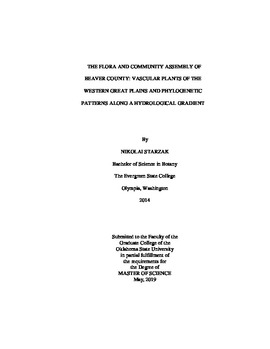| dc.description.abstract | Beaver County has the lowest plant collections per area of any county in western Oklahoma, and is located in the understudied shortgrass/mixed-grass prairies of the western Great Plains. The region has a history of high disturbance with a low proportion of protected areas and high risk for climate change induced drought. Through field work and herbarium specimen study, I documented a list of the vascular plants of the county, recording 497 vascular plant species. To facilitate the collection effort of a county-level floristic study, I developed methods for identifying knowledge gaps in the known flora. Using soil, geological, and hydrological maps, I identified intersections of unique environments as candidates for sampling in the 4700 km2 county. By querying data from other shortgrass and mixed-grass prairie floras, I produced a checklist of likely plants in Beaver County. Utilizing these methods, I documented 60 new county records in two field seasons, including one state record, Gutierrezia sphaerocephala, roundleaf snakeweed (Asteraceae). Species-rich families were typical for the Great Plains: Asteraceae (19.4% of the flora), Poaceae (16.4%), and Fabaceae (8%). The largest genera were Oenothera (Onagraceae, 15 species), Euphorbia (Euphorbiaceae, 14 species), and Eragrostis (Poaceae, 9 species). The four vegetation types in Beaver County, bottomland, stabilized dune, sandsage grassland, and shortgrass prairie, were also recorded and had their species compositions studied. Special attention was paid to introduced species (63 species, 12.7% of the flora), as exotic species can displace native plants. Beaver County floristic data was used to test community assembly hypotheses, by analyzing the phylogenetic relatedness of four communities on a hydrological gradient from river bottom to upland dune. The relatedness of exotic species in each community was also analyzed to infer how species naturalize along a western Great Plains hydrological gradient and inform management of an economically important and anthropogenically disturbed region. Significant phylogenetic clustering, representative of environmental filtering, was found in the wetter communities of the River Bottom and Terrace, while the dunes showed random assemblage. Inclusion of exotic species increased clustering in the wetter communities. Possible abiotic factors that filter plants are drought and salinity. | |
